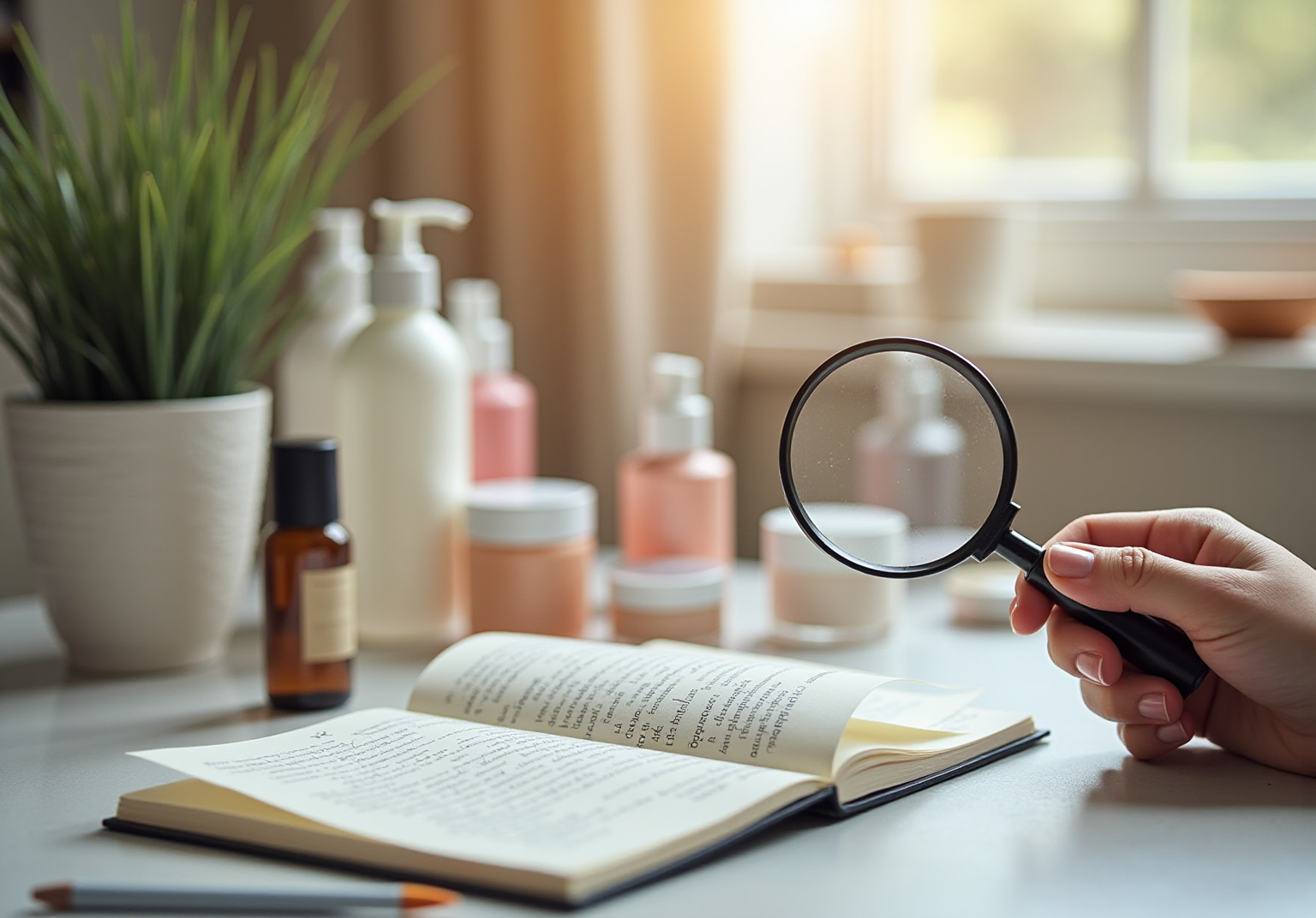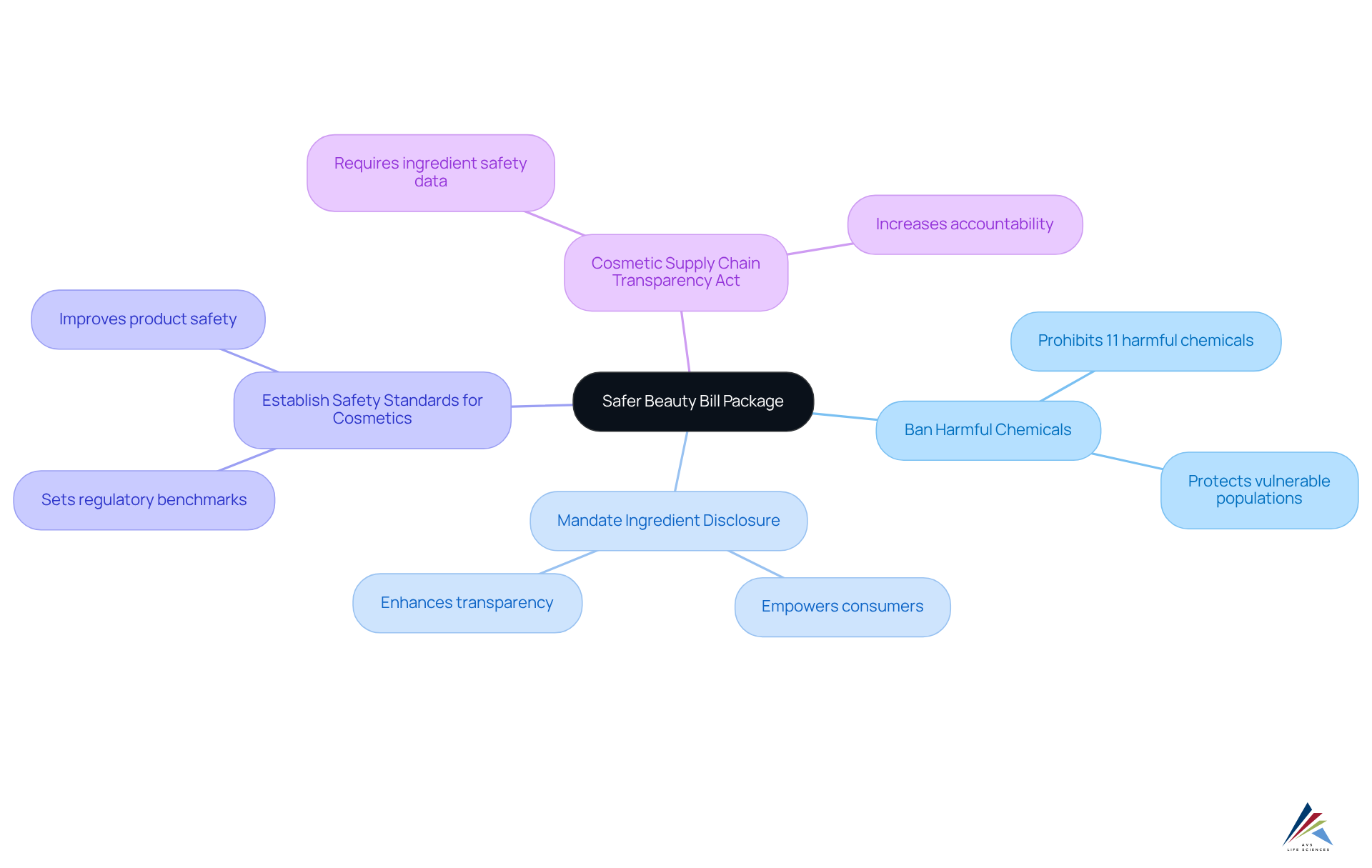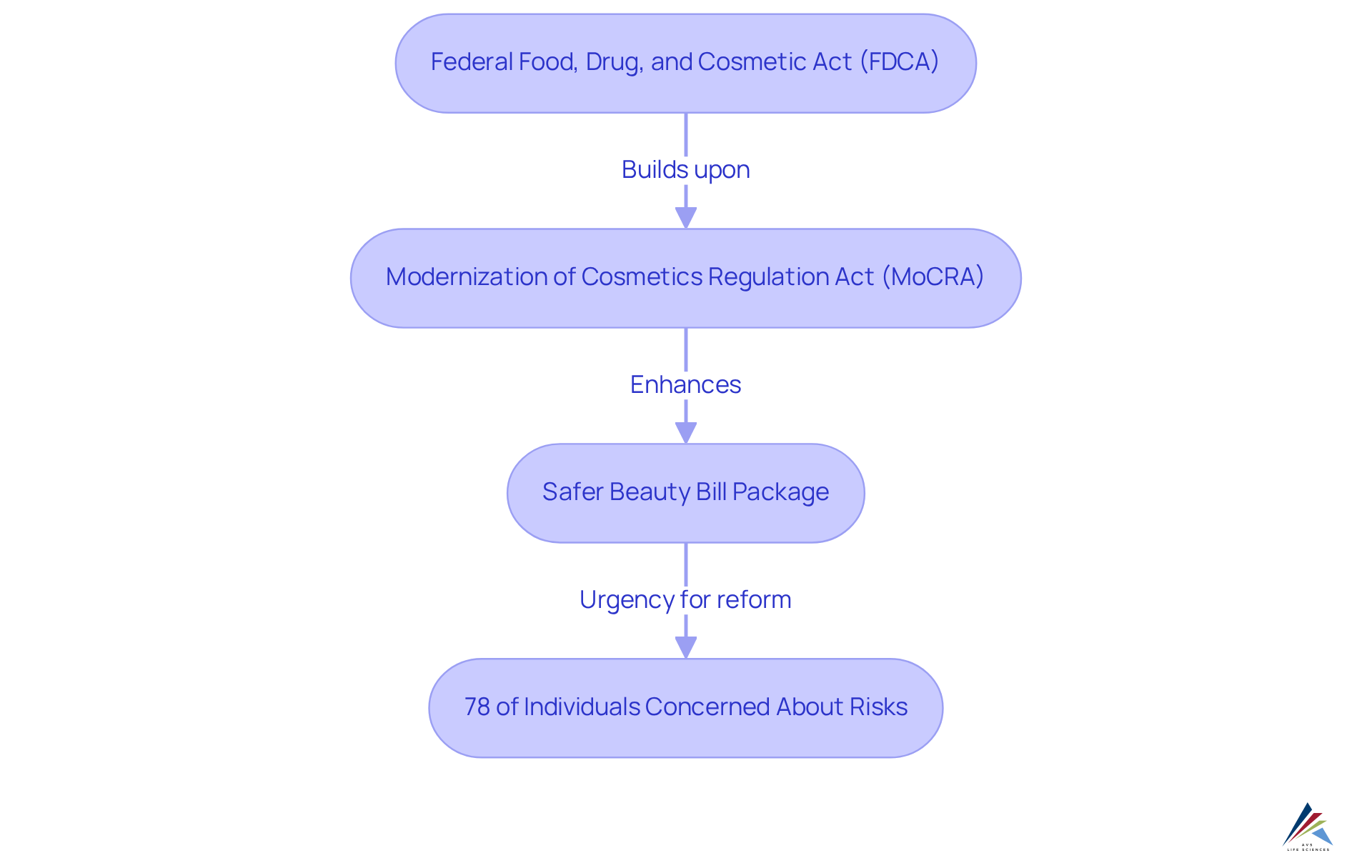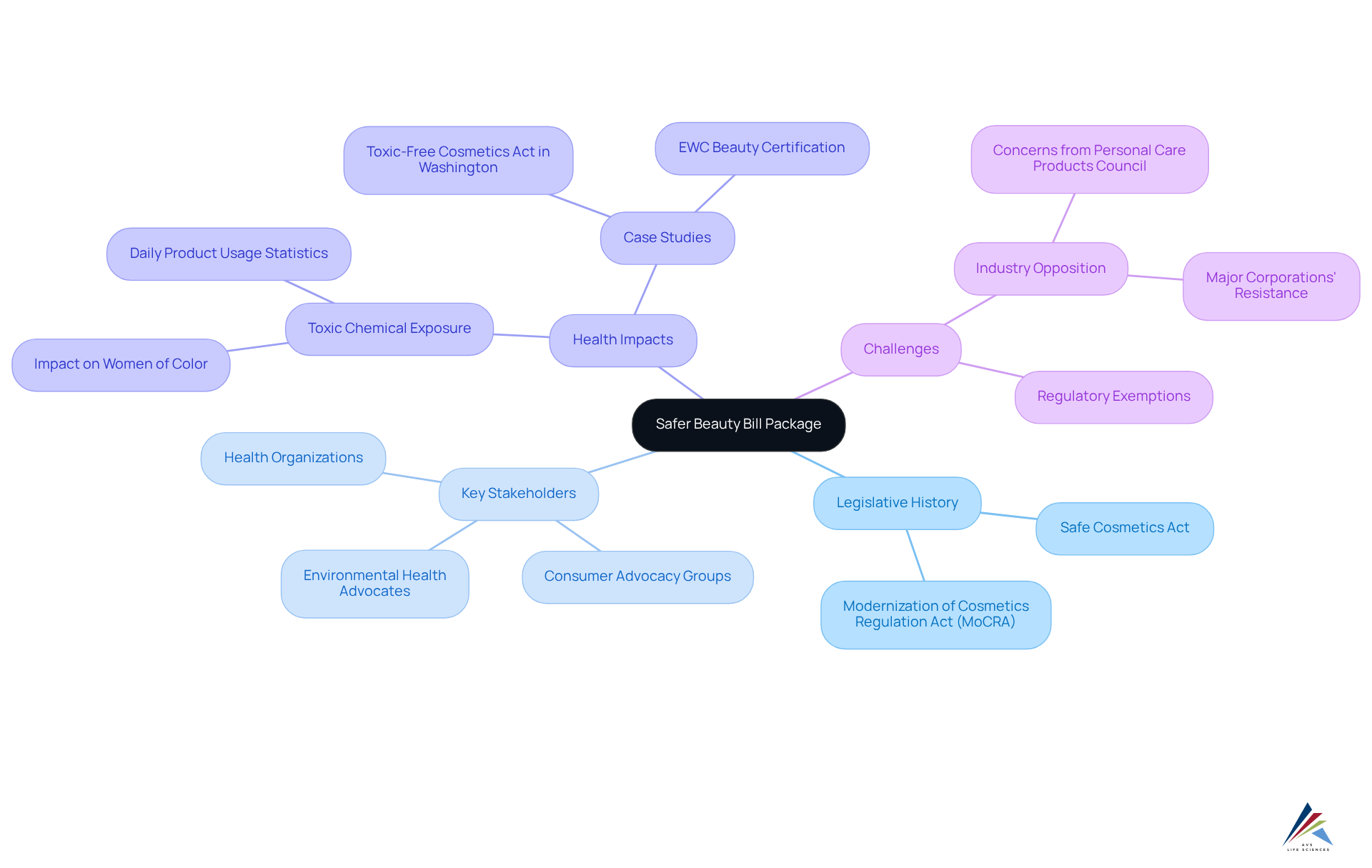What the Safer Beauty Bill Package Means for Cosmetic Formulation

Overview
The Safer Beauty Bill Package represents a significant transformation in cosmetic formulation, as it bans harmful chemicals and mandates complete ingredient disclosure. This legislative initiative not only enhances consumer safety and transparency but also addresses critical gaps in existing regulations, particularly for marginalized communities. Furthermore, it promotes innovation within the beauty industry, compelling companies to adapt and meet these new safety standards. As compliance challenges arise, it is essential for industry stakeholders to engage with these changes proactively, ensuring alignment with the evolving regulatory landscape.
Introduction
The landscape of personal care products is poised for a significant transformation with the introduction of the Safer Beauty Bill Package. This legislative initiative aims to enhance the safety and transparency of cosmetics, addressing critical compliance challenges in the industry. By seeking to ban harmful chemicals and mandate ingredient disclosure, it underscores the pressing need for consumer protection, particularly for marginalized groups disproportionately affected by toxic substances.
As the beauty industry confronts these regulatory changes, one must consider:
- Will these new standards genuinely foster a safer environment?
- Will they encounter resistance from powerful industry stakeholders?
Define the Safer Beauty Bill Package
The Safer Care Bill Package represents a comprehensive legislative initiative designed to enhance the safety and transparency of personal care items across the United States. This package comprises four pivotal bills that collectively aim to:
- Ban
- Mandate
- Establish
By addressing significant shortcomings in existing regulations, the endeavors to and protect individuals, particularly at-risk groups such as women of color and salon employees, from the detrimental effects of .
Notably, studies reveal that methyl paraben levels are twice as high among Non-Hispanic Black women compared to their Non-Hispanic White counterparts, underscoring the urgent need for targeted protections.
Additionally, the Cosmetic Supply Chain Transparency Act emphasizes what the safer beauty bill package means for cosmetic formulation by highlighting the importance of [ingredient disclosure](https://uclawreview.org/2024/03/06/clean-beauty-a-void-in-consumer-protection) and safety information, which empowers individuals to make informed choices.
This legislation not only enhances consumer protection but also aligns with the growing demand for accountability and transparency within the beauty sector, potentially paving the way for a .

Contextualize the Safer Beauty Bill Package in Regulatory Frameworks
The Safer Products Bill Package emerges from a regulatory framework that has historically offered limited oversight of the personal care sector. Previously, the (FDCA) established a safety standard for beauty products; however, significant gaps remained, particularly regarding . The (MoCRA) introduced a degree of regulation, yet it fell short in adequately addressing these concerns.
The builds upon MoCRA by defining what the safer beauty bill package means for through more stringent regulations, including the prohibition of certain such as parabens and phthalates, as well as mandating . This legislative initiative signifies an increasing acknowledgment of what the safer beauty bill package means for cosmetic formulation, especially as associated with unregulated cosmetic products continues to grow.
Notably, 78% of individuals express concern about the risks linked to personal care items, underscoring the urgency for these . Experts in the regulatory field assert that these changes are critical for empowering consumers to make informed choices about the products they apply to their skin and hair, which ties into what the safer beauty bill package means for cosmetic formulation, ultimately fostering a safer beauty environment.

Trace the Origins and Development of the Safer Beauty Bill Package
The Safer Product Bill Package emerges from a sustained effort to enhance the safety of personal care items, illustrating what the means for , driven by concerns regarding the of . Earlier legislative initiatives, such as the Safe Cosmetics Act, have set the stage for broader reforms. The recent reintroduction of the Safer Cosmetic Bill Package in July 2025 illustrates what the safer beauty bill package means for cosmetic formulation, representing the culmination of years of advocacy, research, and public demand for safer cosmetic products. Key stakeholders, including health organizations and consumer advocacy groups, have been instrumental in shaping this package, underscoring the necessity for transparency and accountability within the beauty industry.
A critical legislative backdrop for the Safer Product Bill Package is the (MoCRA), which highlights what the safer beauty bill package means for cosmetic formulation by significantly expanding the FDA's authority to regulate personal care products. This legislation aims to and clarifies what the safer beauty bill package means for cosmetic formulation. Additionally, the EWC Beauty Certification, which enforces stringent safety and transparency standards in the beauty sector, further strengthens the initiative toward safer products.
Statistics reveal that individuals typically use between six to twelve beauty products daily, emphasizing the urgent need for regulation to protect consumer health. Advocacy organizations have pointed out the disproportionate impact of harmful chemicals on marginalized communities, particularly women of color, who face higher exposure levels to toxic substances in beauty products. Notable case studies, such as the , demonstrate the effectiveness of legislative efforts in prohibiting harmful chemicals like PFAS and formaldehyde, thereby enhancing public health outcomes.
Nevertheless, the Safer Personal Care Bill Package has encountered resistance from organizations like the Personal Care Products Council and major corporations such as L’Oreal and Unilever, which express concerns regarding the ramifications of banning specific chemicals without recognizing the existence of safer alternatives. As the Safer Aesthetic Legislation Package progresses, it aims to bolster advocacy efforts by clarifying what the safer beauty bill package means for cosmetic formulation, ensuring that products are safe and free from known harmful substances, thereby fostering a healthier environment for all consumers.

Analyze Implications for Cosmetic Formulation Under the Safer Beauty Bill Package
The is set to significantly change by instituting bans on . This regulatory shift compels manufacturers to reformulate their offerings in light of [what the safer beauty bill package means for cosmetic formulation](http://avslifesciences.com/blog-post/10-key-insights-for-navigating-the-cgmp-environment), fostering a culture of innovation as companies explore alternative ingredients that align with enhanced safety standards. Notably, clean beauty items experienced an impressive 33% sales rise in the first half of 2021, underscoring the . Additionally, 68% of individuals express a preference for , highlighting a shift in consumer preferences toward safer choices. The requirement for full ingredient disclosure will further bolster transparency, empowering consumers to make informed decisions about the products they apply to their skin. Thus, the Safer Beauty Bill Package embodies what the safer beauty bill package means for cosmetic formulation, representing more than just a ; it signifies a , prioritizing health and safety over convenience and cost.
Case studies, such as the proactive measures taken by brands like Beautycounter, which reported an estimated revenue of $341 million in 2020, illustrate how companies are already adapting to these new standards, positioning themselves as leaders in the . This legislative framework is set to reshape the landscape of beauty product formulation by clarifying what the safer beauty bill package means for cosmetic formulation, steering the industry toward a more responsible and consumer-focused future. Furthermore, reflect a growing recognition of the associated with these chemicals, further emphasizing the necessity for reformulation and innovation within the industry.

Conclusion
The Safer Beauty Bill Package signifies a transformative advancement in ensuring that cosmetic formulations are not only effective but also safe for consumers. By instituting bans on harmful chemicals and mandating full ingredient disclosure, this legislative initiative effectively addresses longstanding gaps in the regulatory framework governing personal care products. It underscores the critical importance of transparency and accountability, particularly for vulnerable populations disproportionately affected by toxic beauty products.
Key aspects of the Safer Beauty Bill Package have been thoroughly explored, including its historical context, implications for cosmetic formulation, and the rising public demand for safer beauty products. The package's emphasis on banning toxic substances like parabens and phthalates, alongside the push for clearer ingredient labeling, empowers consumers to make informed choices. Furthermore, the increasing trend toward clean beauty products illustrates a significant shift in consumer preferences, reinforcing the necessity for manufacturers to adapt to these new standards.
Ultimately, the Safer Beauty Bill Package represents a pivotal moment in the beauty industry, urging stakeholders to prioritize health and safety over convenience and profit. As the landscape of cosmetic formulation evolves, collaboration among consumers, manufacturers, and policymakers becomes essential in fostering a safer beauty environment. Embracing these changes not only protects individual health but also promotes a more responsible and sustainable industry, ensuring that beauty products enhance well-being rather than compromise it.
Frequently Asked Questions
What is the Safer Beauty Bill Package?
The Safer Beauty Bill Package is a legislative initiative aimed at enhancing the safety and transparency of personal care items in the United States, consisting of four key bills that focus on banning harmful chemicals, mandating ingredient disclosure, and establishing safety standards for cosmetics.
What are the main goals of the Safer Beauty Bill Package?
The main goals are to ban harmful chemicals in beauty products, require ingredient disclosure to consumers, and set safety standards for cosmetics to protect individuals, especially at-risk groups like women of color and salon employees.
Why is the Safer Beauty Bill Package necessary?
The package addresses significant gaps in existing regulations regarding cosmetic safety, particularly in light of studies showing higher levels of harmful substances like methyl paraben among Non-Hispanic Black women compared to Non-Hispanic White women, highlighting the need for targeted protections.
What does the Cosmetic Supply Chain Transparency Act entail?
The Cosmetic Supply Chain Transparency Act focuses on the importance of ingredient disclosure and safety information, empowering consumers to make informed choices about the beauty products they use.
How does the Safer Beauty Bill Package benefit consumers?
It enhances consumer protection by ensuring safer beauty products, promoting accountability and transparency in the beauty industry, and potentially creating a standardized definition of 'clean' products.
